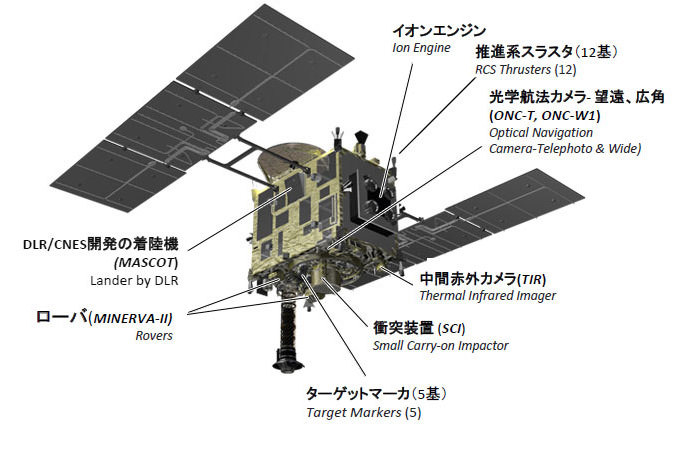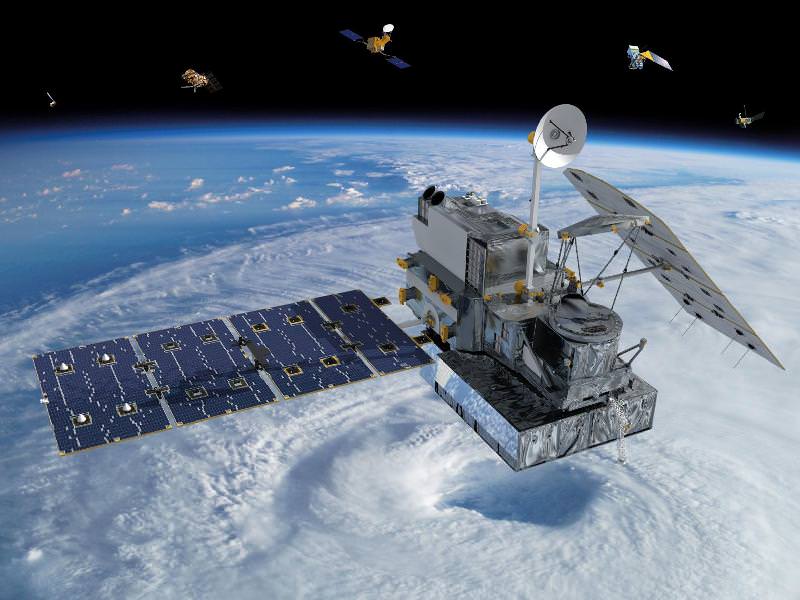Host: Fraser Cain (@fcain)
Special Guest: Bas Lansdorp, CEO of Mars One
Guests:
Morgan Rehnberg (cosmicchatter.org / @MorganRehnberg )
Brian Koberlein (@briankoberlein)
Alessondra Springmann (@sondy)
Dave Dickinson (@astroguyz / www.astroguyz.com)
Continue reading “Weekly Space Hangout – April 24, 2015: Bas Lansdorp, CEO of Mars One”
There Could Be Lava Tubes on the Moon, Large Enough for Whole Cities
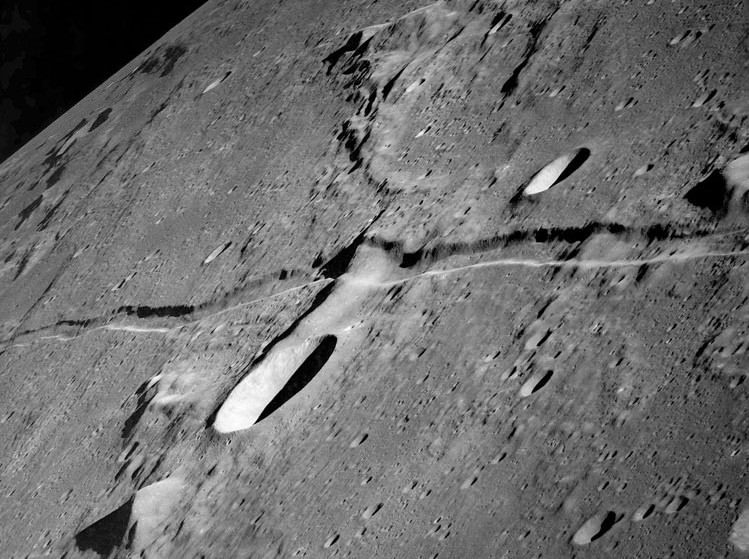
Every year since 1970, astronomers, geologists, geophysicists, and a host of other specialists have come together to participate in the Lunar and Planetary Science Conference (LPCS). Jointly sponsored by the Lunar and Planetary Institute (LPI) and NASA’s Johnson Space Center (JSC), this annual event is a chance for scientists from all around the world to share and present the latest planetary research concerning Earth’s only moon.
This year, one of the biggest attention-grabbers was the findings presented on Tuesday, March 17th by a team of students from Purdue University. Led by a graduate student from the university’s Department of Earth, Atmospheric and Planetary Sciences, the study they shared indicates that there may be stable lava tubes on the moon, ones large enough to house entire cities.
In addition to being a target for future geological and geophysical studies, the existence of these tubes could also be a boon for future human space exploration. Basically, they argued, such large, stable underground tunnels could provide a home for human settlements, shielding them from harmful cosmic radiation and extremes in temperature.
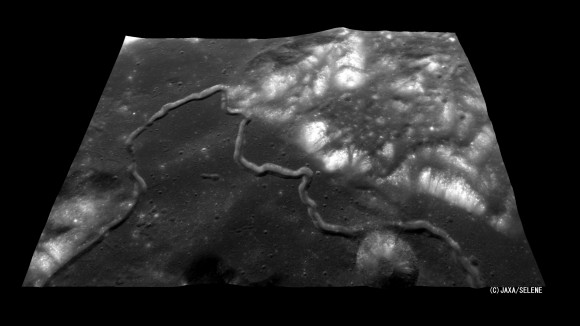
Lava tubes are natural conduits formed by flowing lava that is moving beneath the surface as a result of a volcanic eruption. As the lava moves, the outer edges of it cools, forming a hardened, channel-like crust which is left behind once the lava flow stops. For some time, Lunar scientists have been speculating as to whether or not lava flows happen on the Moon, as evidenced by the presence of sinuous rilles on the surface.
Sinuous rilles are narrow depressions in the lunar surface that resemble channels, and have a curved paths that meanders across the landscape like a river valley. It is currently believed that these rilles are the remains of collapsed lava tubes or extinct lava flows, which is backed up by the fact they usually begin at the site of an extinct volcano.
Those that have been observed on the Moon in the past range in size of up to 10 kilometers in width and hundreds of kilometers in length. At that size, the existence of a stable tube – i.e. one which had not collapsed to form a sinuous rille – would be large enough to accommodate a major city.
For the sake of their study, the Purdue team explored whether lava tubes of the same scale could exist underground. What they found was that the stability of a lava tube depended on a number of variables- including width, roof thickness and the stress state of the cooled lava. he researchers also modeled lava tubes with walls created by lava placed in one thick layer and with lava placed in many thin layers.

David Blair, a graduate student in Purdue’s Department of Earth, Atmospheric and Planetary Sciences, led the study that examined whether empty lava tubes more than 1 kilometer wide could remain structurally stable on the moon.
“Our work is somewhat unique in that we’ve combined the talents of people from various Departments at Purdue,” Blair told Universe Today via email. “With guidance from Prof. Bobet (a civil engineering professor) we’ve been able to incorporate a modern understanding of rock mechanics into our computer models of lava tubes to see how they might actually fail and break under lunar gravity.”
For the sake of their research, the team constructed a number of models of lava tubes of different sizes and with different roof thicknesses to test for stability. This consisted of them checking each model to see if it predicted failure anywhere in the lava tube’s roof.
“What we found was surprising,” Blair continued, “in that much larger lava tubes are theoretically possible than what was previously thought. Even with a roof only a few meters thick, lava tubes a kilometer wide may be able to stay standing. The reason why, though, is a little less surprising. The last work we could find on the subject is from the Apollo era, and used a much simpler approximation of lava tube shape – a flat beam for a roof.
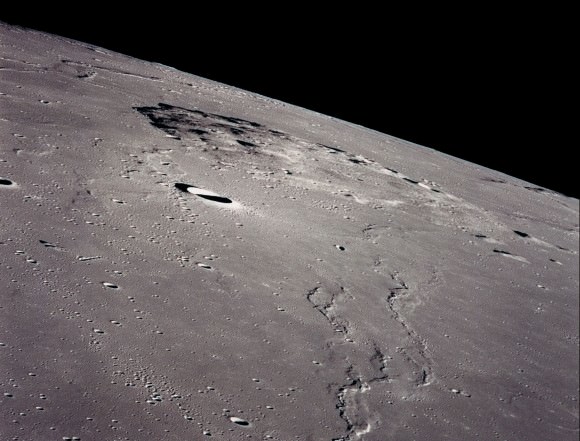
The study he refers to, “On the origin of lunar sinuous rilles“, was published in 1969 in the journal Modern Geology. In it, professors Greeley, Oberbeck and Quaide advanced the argument that sinuous rilles formation was tied to the collapse of lava flow tubes, and that stable ones might still exist. Calculating for a flat-beam roof, their work found a maximum lava tube size of just under 400 m.
“Our models use a geometry more similar to what’s seen in lava tubes on Earth,” Blair said, “a sort of half-elliptical shape with an arched roof. The fact that an arched roof lets a larger lava tube stay standing makes sense: humans have known since antiquity that arched roofs allow tunnels or bridges to stay standing with wider spans.”
The Purdue study also builds on previous studies conducted by JAXA and NASA where images of “skylights” on the Moon – i.e. holes in the lunar surface – confirmed the presence of caverns at least a few tens of meters across. The data from NASA’s lunar Gravity Recovery And Interior Laboratory (GRAIL) – which showed big variations in the thickness of the Moon’s crust is still being interpreted, but could also be an indication of large subsurface recesses.
As a result, Blair is confident that their work opens up new and feasible explanations for many different types of observations that have been made before. Previously, it was unfathomable that large, stable caverns could exist on the Moon. But thanks to his team’s theoretical study, it is now known that under the proper conditions, it is least possible.
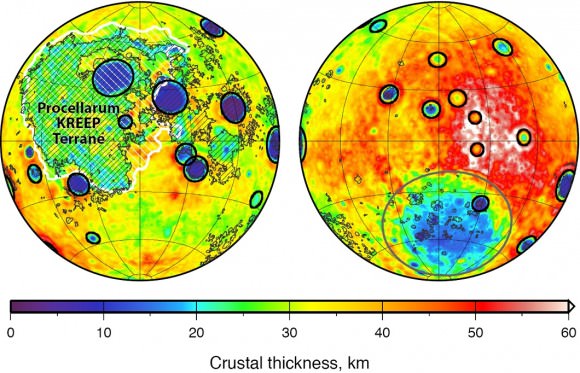
Another exciting aspect that this work is the implications it offers for future exploration and even colonization on the Moon. Already, the issue of protection against radiation is a big one. Given that the Moon has no atmosphere, colonists and agricultural operations will have no natural shielding from cosmic rays.
“Geologically stable lava tubes would absolutely be a boon to human space exploration,” Blair commented. “A cavern like that could be a really ideal place for building a lunar base, and generally for supporting a sustained human presence on the Moon. By going below the surface even a few meters, you suddenly mitigate a lot of the problems with trying to inhabit the lunar surface.”
Basically, in addition to protecting against radiation, a subsurface base would sidestep the problems of micrometeorites and the extreme changes in temperature that are common on the lunar surface. What’s more, stable, subsurface lava tubes could also make the task of pressurizing a base for human habitation easier.
“People have studied and talked about all of these things before,” Blair added, “but our work shows that those kinds of opportunities could potentially exist – now we just have to find them. Humans have been living in caves since the beginning, and it might make sense on the Moon, too!”
In addition to Melosh, Blair and Bobet, team members include Loic Chappaz and Rohan Sood, graduate students in the School of Aeronautics and Astronautics; Kathleen Howell, Purdue’s Hsu Lo Professor of Aeronautical and Astronautical Engineering; Andy M. Freed, an associate professor of earth, atmospheric and planetary sciences; and Colleen Milbury, a postdoctoral research associate in the Department of Earth, Atmospheric and Planetary Sciences.
Further Reading: Purdue News
CATS Out of The Bag, Crawling Around ISS for Science Down Below
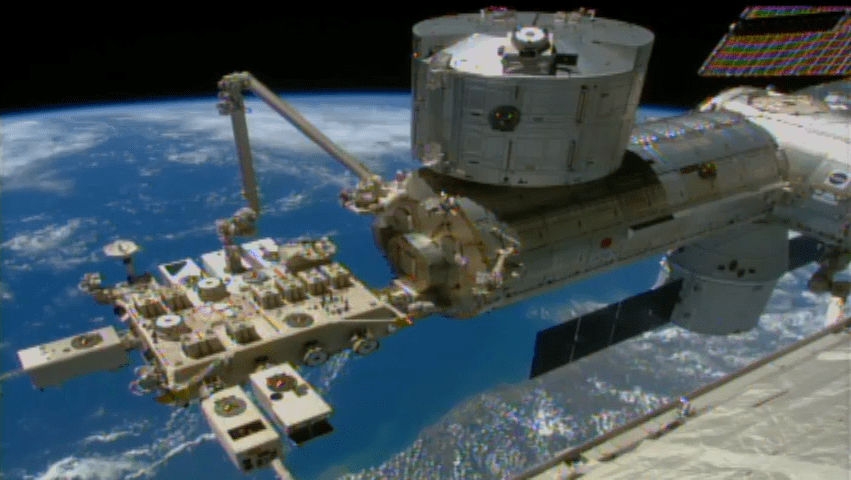
The Japanese robotic arm installs the CATS experiment on an external platform on Japan’s Kibo lab module. The SpaceX Dragon commercial cargo craft is seen at the right center of the image. Credit: NASA TV
See way cool installation video below[/caption]
“Robotic controllers let the CATS out of the bag!” So says NASA spokesman Dan Huot in a cool new NASA timelapse video showing in detail how CATS crawled around the space stations gangly exterior and clawed its way into its new home – topped off with a breathtaking view of our home planet that will deliver science benefits to us down below.
The CATS experiment was installed on the exterior of the International Space Station (ISS) via a first ever type of robotic handoff, whereby one of the stations robotic arms handed the rectangular shaped instrument off to a second robotic arm. Sort of like relays runners passing the baton while racing around the track for the gold medal.
In this case it was all in the name of science. CATS is short for Cloud Aerosol Transport System.
Ground controllers at NASA’s Johnson Space Center in Houston plucked CATS out of the truck of the recently arrived SpaceX Dragon cargo delivery vehicle with the Special Purpose Dexterous Manipulator (Dextre). Then they passed it off to a Japanese team of controllers at JAXA, manipulating the second arm known as the Japanese Experiment Module Remote Manipulator System. The JAXA team then installed CATS onto an external platform on Japans Kibo laboratory.
CATS is a new Earth Science instrument dedicated to collecting continuous data about clouds, volcanic ash plumes and tiny airborne particles that can help improve our understanding of aerosol and cloud interactions and improve the accuracy of climate change models.
The remote-sensing laser instrument measures clouds and the location and distribution of pollution, dust, smoke, and other particulates and aerosols in the atmosphere that directly impacts the global climate.
Data from CATS will be used to derive properties of cloud/aerosol layers at three wavelengths: 355, 532, 1064 nm.
Check out this cool NASA ‘Space to Ground’ video showing CATS installation
Video caption: NASA’s Space to Ground on 1/23/15 covers CATS Out of The Bag. This is your weekly update on what’s happening aboard the International Space Station. Got a question or comment? Use #spacetoground to talk to us.
All the movements were conducted overnight by robotic flight controllers on the ground. They installed CATS to an external platform on Japan’s Kibo lab module.
CATS is helping to open a new era on the space station research dedicated to expanding its use as a science platform for making extremely valuable remote sensing observations for Earth Science.
The CATS instrument is the fourth successful NASA Earth science launch out of five scheduled during a 12-month period. And it is the second to be installed on the exterior of the ISS, following ISS-RapidScat that was brought by the SpaceX CRS-4 Dragon.
The fifth launch — the Soil Moisture Active Passive satellite — is scheduled for Jan. 29 from Vandenberg Air Force Base in California.
CATS was launched to the station as part of the payload aboard the SpaceX Dragon CRS-5 cargo vessel bolted atop the SpaceX Falcon 9 for the spectacular nighttime blastoff on Jan. 10 at 4:47 a.m. EST from Cape Canaveral Air Force Station in Florida.
CATS was loaded in the unpressurized rear trunk section of Dragon.
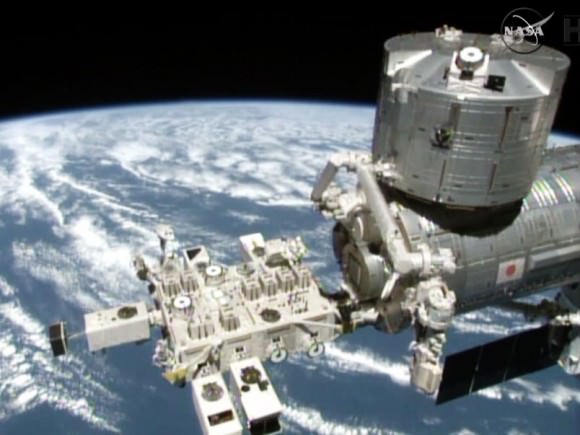
The new CATS experiment delivered by the SpaceX commercial cargo craft will be installed on a platform outside Japan’s Kibo Laboratory module. Credit: NASA
The Dragon CRS-5 spacecraft was loaded with over 5108 pounds (2317 kg) of scientific experiments, technology demonstrations, the CATS science payload, student research investigations, crew supplies, spare parts, food, water, clothing and assorted research gear for the six person crew serving aboard the ISS.
It successfully rendezvoused at the station on Jan. 12 after a two day orbital chase, delivering the critical cargo required to keep the station stocked and humming with science.
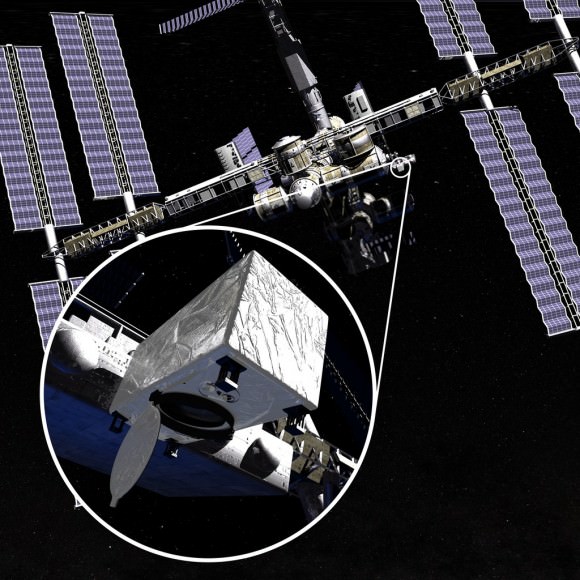
Stay tuned here for Ken’s continuing Earth and planetary science and human spaceflight news.
Japan’s Akatsuki Spacecraft to Make Second Attempt to Enter Orbit of Venus in December 2015
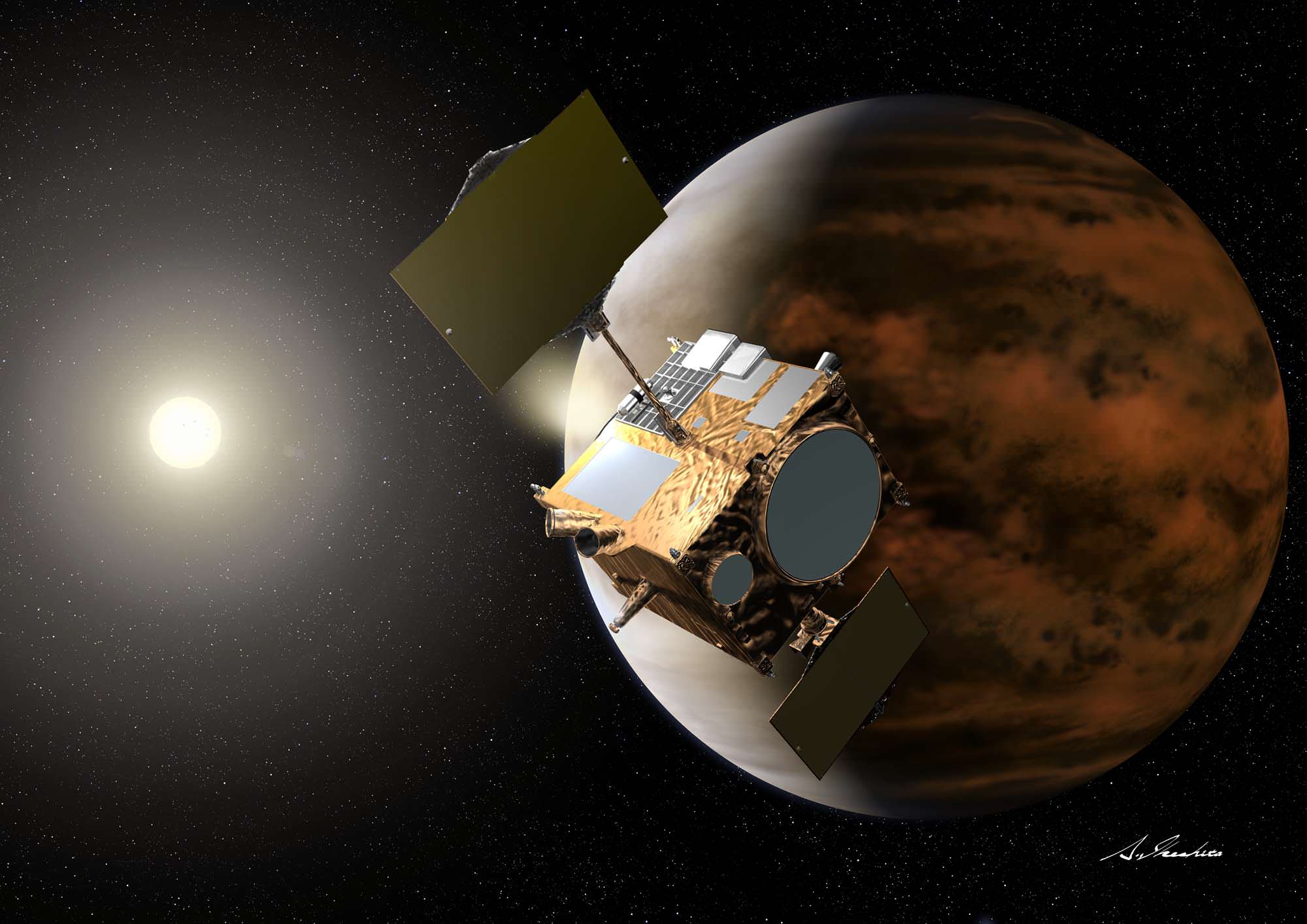
Back in 2010, the Japanese Aerospace Exploration Agency (JAXA) launched the The Venus Climate Orbiter “Akatsuki” with the intention of learning more about the planet’s weather and surface conditions. Unfortunately, due to engine trouble, the probe failed to make it into the planet’s orbit.
Since that time, it has remained in a heliocentric orbit, some 134 million kilometers from Venus, conducting scientific studies on the solar wind. However, JAXA is going to make one more attempt to slip the probe into Venus’ orbit before its fuel runs out.
Since 2010, JAXA has been working to keep Akatsuki functioning so that they could give the spacecraft another try at entering Venus’ orbit.
After a thorough examination of all the possibilities for the failure, JAXA determined that the probe’s main engine burned out as it attempted to decelerate on approach to the planet. They claim this was likely due to a malfunctioning valve in the spacecraft’s fuel pressure system caused by salt deposits jamming the valve between the helium pressurization tank and the fuel tank. This resulted in high temperatures that damaged the engine’s combustion chamber throat and nozzle.

JAXA adjusted the spacecraft’s orbit so that it would establish a heliocentric orbit, with the hopes that it would be able to swing by Venus again in the future. Initially, the plan was to make another orbit insertion attempt by the end 2016 when the spacecraft’s orbit would bring it back to Venus. But because the spacecraft’s speed has slowed more than expected, JAXA determined if they slowly decelerated Akatsuki even more, Venus would “catch up with it” even sooner. A quicker return to Venus would also be advantageous in terms of the lifespan of the spacecraft and its equipment.
But this second chance will likely be the final chance, depending on how much damage there is to the engines and other systems. The reasons for making this final attempt are quite obvious. In addition to providing vital information on Venus’ meteorological phenomena and surface conditions, the successful orbital insertion of Akatsuki would also be the first time that Japan deployed a satellite around a planet other than Earth.
If all goes well, Akatsuki will enter orbit around Venus at a distance of roughly 300,000 to 400,000 km from the surface, using the probe’s 12 smaller engines since the main engine remains non-functional. The original mission called for the probe to establish an elliptical orbit that would place it 300 to 80,000 km away from Venus’ surface.
This wide variation in distance was intended to provide the chance to study the planet’s meteorological phenomena and its surface in detail, while still being able to observe atmospheric particles escaping into space.
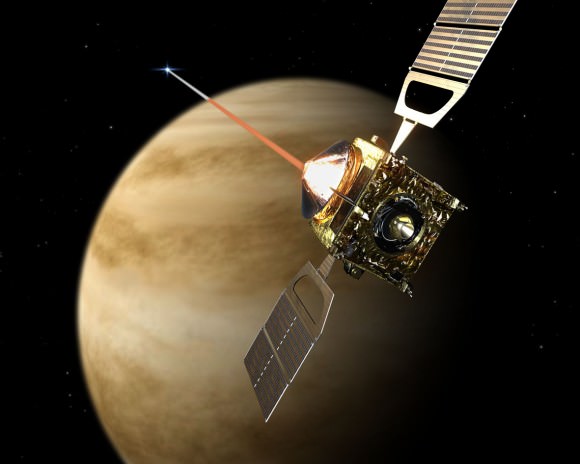
At a distance of 400,000 km, the image quality and opportunities to capture them are expected to be diminished. However, JAXA is still confident that it will be able to accomplish most of the mission’s scientific goals.
In its original form, these goals included obtaining meteorological information on Venus using four cameras that capture images in the ultraviolet and infrared wavelengths. These would be responsible for globally mapping clouds and peering beneath the veil of the planet’s thick atmosphere.
Lightning would be detected with a high-speed imager, and radio-science monitors would observe the vertical structure of the atmosphere. In so doing, JAXA hopes to confirm the existence of surface volcanoes and lighting, both of which were first detected by the ESA’s Venus Express spacecraft. One of the original aims of Akatsuki was to complement the Venus Express mission. But Venus Express has now completed its mission, running out of gas and plunging into the planet’s atmosphere.
But most of all, it is hoped that Akatsuki can provide observational data on the greatest mystery of Venus, which has to do with its surface storms.

Previous observations of the planet have shown that winds that can reach up to 100 m/s (360 km/h or ~225 mph) circle the planet every four to five Earth days. This means that Venus experiences winds that are up to 60 times faster than the speed at which the planet turns, a phenomena known as “Super-rotation”.
Here on Earth, the fastest winds are only capable of reaching between 10 and 20 percent of the planet’s rotation. As such, our current meteorological understanding does not account for these super-high speed winds, and it is hoped that more information on the atmosphere will provide some clues as to how this can happen.
Between the extremely thick clouds, sulfuric rain storms, lightning, and high-speed winds, Venus’ atmosphere is certainly very interesting! Add to the fact that the volcanic, pockmarked surface cannot be surveyed without the help of sophisticated radar or IR imaging, and you begin to understand why JAXA is eager to get their probe into orbit while they still can.
And be sure to check out this video, courtesy of JAXA, detailing the Venus Climate Orbiter mission:
Further Reading: JAXA
Weekly Space Hangout – Dec. 19, 2014: Methane on Mars!
Host: Fraser Cain (@fcain)
Guests:
Morgan Rehnberg (cosmicchatter.org / @cosmic_chatter)
Ramin Skibba (@raminskibba)
Alessondra Springmann (@sondy)
Continue reading “Weekly Space Hangout – Dec. 19, 2014: Methane on Mars!”
Japan Successfully Launches Hayabusa 2 Asteroid Sample Return Mission
Japan successfully launched their Hayabusa-2 sample return mission to asteroid 1999 JU3, and JAXA reports the spacecraft is on course and in excellent shape, with its solar panels deployed. The H-IIA F26 rocket carrying the craft blasted off from the Tanegashima Space Center in southwest Japan at 1:22:04 p.m. local time on Dec 3, 2014 (04:22 UTC) , and about two hours later, the spacecraft separated from the rocket and entered its initial planned trajectory.
Hayabusa 2 has been communicating with JAXA mission control as it starts off on its journey to land on an asteroid in 2018 and retrieve rock and dust samples to be returned to Earth in late 2020.
The first Hayabusa spacecraft completed a successful — albeit nail-biting — mission to the asteroid Itokawa, returning samples to Earth in 2010 after first reaching the asteroid in 2005. The mission almost failed as the spacecraft was plagued by technical problems and it wasn’t certain if the mechanism used to capture the samples actually worked. Ultimately, after a circuitous and troubled-filled return trip home, the canister containing microscopic rock samples made a soft landing in Australia, the first time that samples from an asteroid had been brought back to Earth for study.
Hayabusa 2’s target, Asteroid 1999 JU3 is approximately 914 meters (3,000 feet) in diameter, a little larger than Itokawa, and is roughly spherical in shape, while Itokawa had an oblong shape. 1999 JU3 has a rotation period of approximately 7.6 hours.
Relative size of Asteroid 1999 JU3. pic.twitter.com/lIHXVasJoY
— Ron Baalke (@RonBaalke) December 3, 2014
To avoid a repetition of the glitches experienced by the first Hayabusa spacecraft, JAXA made several changes. Hayabusa 2 has an updated ion propulsion engine as well as improved guidance and navigation systems, new antennas and a new altitude control system.
Hayabusa 2 has a mini rover called Minerva 2, and for Hayabusa 2’s sample-collecting activities, a slowly descending impactor will be used, detonating upon contact with the surface instead of the high-speed projectile used by the first Hayabusa.
This video explains the Hayabusa 2 mission and how it differs from the first Hayabusa spacecraft:
JAXA’s Hayabusa website will provide current updates to the mission.
This Was the Best Watched Solar Flare Ever
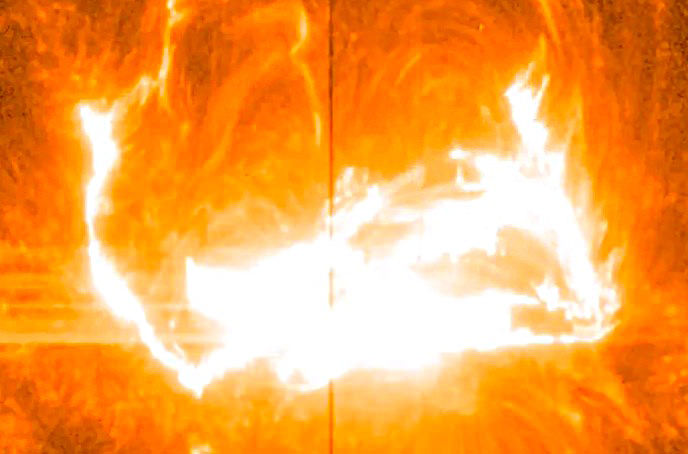
Are giant dragons flying out of the Sun? No, this is much more awesome than that: it’s an image of an X-class flare that erupted from active region 2017 on March 29, as seen by NASA’s Interface Region Imaging Spectrograph (IRIS) spacecraft. It was not only IRIS’s first view of such a powerful flare, but with four other solar observatories in space and on the ground watching at the same time it was the best-observed solar flare ever.
(But it does kind of look like a dragon. Or maybe a phoenix. Ah, pareidolia!)
Check out a video from NASA’s Goddard Space Flight Center below:
In addition to IRIS, the March 29 flare was observed by NASA’s Solar Dynamics Observatory (SDO), NASA’s Reuven Ramaty High Energy Solar Spectroscopic Imager (RHESSI), JAXA and NASA’s Hinode spacecraft, and the National Solar Observatory’s Dunn Solar Telescope in New Mexico.
With each telescope equipped with instruments specially designed to observe the Sun in specific wavelengths almost no detail of this particular flare went unnoticed, giving scientists comprehensive data on the complex behavior of a single solar eruption.
Also, for another look at this flare from SDO and a coronal dimming event apparently associated with it, check out Dean Pesnell’s entry on the SDO is GO! blog here.
Source: NASA/GSFC
1st Images from New NASA/JAXA GPM Rainfall Measuring Satellite Capture Tropical Cyclone in 3D

KENNEDY SPACE CENTER, FL – Weather researchers worldwide now have the ability to capture unprecedented three-dimensional images and detailed rainfall measurements of cyclones, hurricanes and other storms from space on a global basis thanks to the newest Earth observing weather satellite – jointly developed by the US and Japan.
NASA and the Japan Aerospace Exploration Agency (JAXA) have now released the first images captured by their Global Precipitation Measurement (GPM) Core Observatory satellite.
GPM soared to space on Feb. 27, exactly one month ago, during a spectacular night launch from the Japanese spaceport at the Tanegashima Space Center on Tanegashima Island off southern Japan.
The newly released series of images show precipitation falling inside a vast extra-tropical cyclone cascading over a vast swath of the northwest Pacific Ocean, approximately 1,000 miles off the coast of eastern Japan.
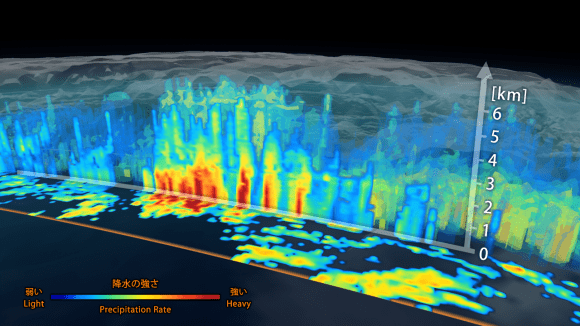
“It was really exciting to see this high-quality GPM data for the first time,” said GPM project scientist Gail Skofronick-Jackson at NASA’s Goddard Spaceflight Center in Greenbelt, Md., in a NASA statement.
“I knew we had entered a new era in measuring precipitation from space. We now can measure global precipitation of all types, from light drizzle to heavy downpours to falling snow.”
The imagery was derived from measurements gathered by GPM’s two advanced instruments: JAXA’s high resolution dual-frequency precipitation (DPR) radar instrument (Ku and Ka band), which imaged a three-dimensional cross-section of the storm, and the GPM microwave imager (GMI) built by Ball Aerospace in the US which observed precipitation across a broad swath.
“The GMI instrument has 13 channels that measure natural energy radiated by Earth’s surface and also by precipitation itself. Liquid raindrops and ice particles affect the microwave energy differently, so each channel is sensitive to a different precipitation type,” according to a NASA statement.
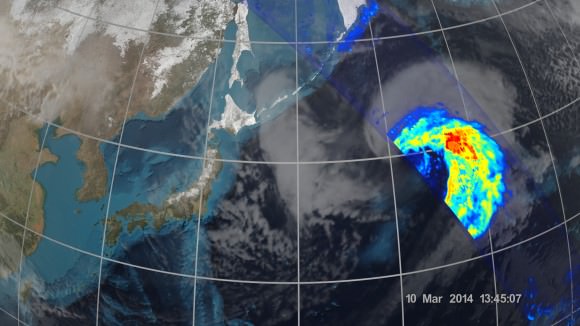
The 3850 kilogram GPM observatory is the first satellite designed to measure light rainfall and snow from space, in addition to heavy tropical rainfall.
The data were released following check out and activation of the satellites pair of instruments.
“GPM’s precipitation measurements will look like a CAT scan,” Dr. Dalia Kirschbaum, GPM research scientist, told me during a prelaunch interview with the GPM satellite in the cleanroom at NASA’s Goddard Space Flight Center in Greenbelt, Md.
“The radar can scan through clouds to create a three dimensional view of a clouds structure and evolution.”
The $933 Million GPM observatory will provide high resolution global measurements of rain and snow every 3 hours. It is a joint venture between NASA and JAXA.
It will collect a treasure trove of data enabling the most comprehensive measurements ever of global precipitation – and across a wide swath of the planet where virtually all of humanity lives from 65 N to 65 S latitudes.
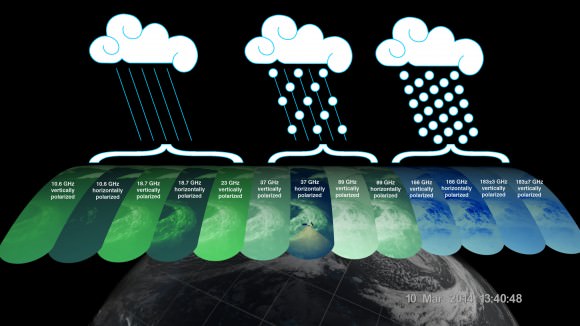
GPM orbits at an altitude of 253 miles (407 kilometers) above Earth – quite similar to the International Space Station (ISS).
GPM is the lead observatory of a constellation of nine highly advanced Earth orbiting weather research satellites contributed by the US, Japan, Europe and India.
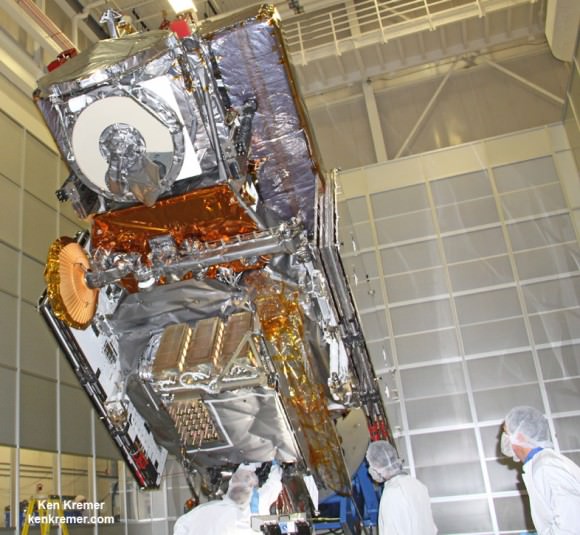
Stay tuned here for Ken’s continuing GPM, Curiosity, Opportunity, Chang’e-3, SpaceX, Orbital Sciences, LADEE, MAVEN, MOM, Mars and more planetary and human spaceflight news.
Learn more at Ken’s upcoming presentations at the NEAF convention on April 12/13 and at Washington Crossing State Park, NJ on April 6. Also at the Quality Inn Kennedy Space Center, Titusville, FL, March 29.
Next Generation NASA/JAXA Global Weather Research Satellite thunders aloft from Japanese Spaceport
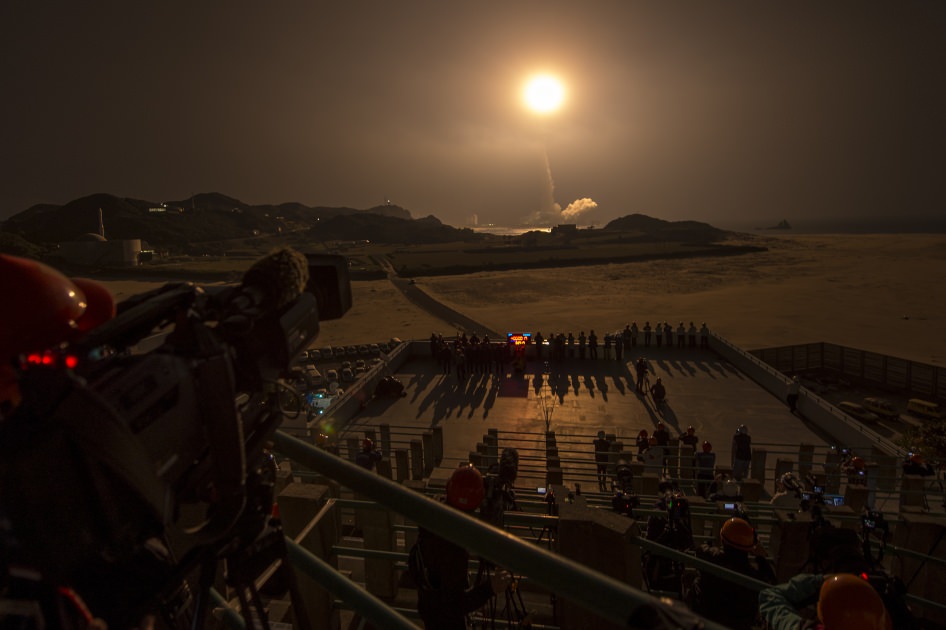
GPM Launch Seen From the Tanegashima Space Center
A Japanese H-IIA rocket with the NASA-Japan Aerospace Exploration Agency (JAXA), Global Precipitation Measurement (GPM) Core Observatory onboard, is seen launching from the Tanegashima Space Center on Friday, Feb. 28, 2014 (Japan Time), in Tanegashima, Japan; Thursday, Feb. 27, EST. Credit: NASA/Bill Ingalls[/caption]
NASA GODDARD SPACE FLIGHT CENTER, MARYLAND – A powerful, next generation weather observatory aimed at gathering unprecedented 3-D measurements of global rain and snowfall rates – and jointly developed by the US and Japan – thundered to orbit today (Feb. 27 EST, Feb. 28 JST) ) during a spectacular night time blastoff from a Japanese space port.
The Global Precipitation Measurement (GPM) Core Observatory was launched precisely on time at 1:37 p.m. EST, 1837 GMT, Thursday, Feb. 27 (3:37 a.m. JST Friday, Feb. 28) atop a Mitsubishi Heavy Industries H-IIA rocket from the Tanegashima Space Center on Tanegashima Island off southern Japan.
Viewers could watch the spectacular liftoff live on NASA TV – which was streamed here at Universe Today.
“GPM’s precipitation measurements will look like a CAT scan,” Dr. Dalia Kirschbaum, GPM research scientist, told me during a prelaunch interview with the GPM satellite in the cleanroom at NASA’s Goddard Space Flight Center in Greenbelt, Md.
“The radar can scan through clouds to create a three dimensional view of a clouds structure and evolution.”
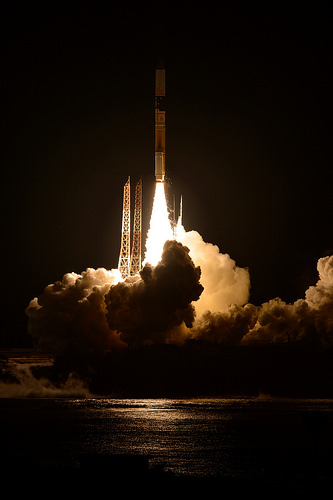
GPM is the lead observatory of a constellation of nine highly advanced Earth orbiting weather research satellites contributed by the US, Japan, Europe and India.
Indeed GPM will be the first satellite to measure light rainfall and snow, in addition to heavy tropical rainfall.
It will collect a treasure trove of data enabling the most comprehensive measurements ever of global precipitation every three hours – and across a wide swath of the planet where virtually all of humanity lives from 65 N to 65 S latitudes.
GPM orbits at an altitude of 253 miles (407 kilometers) above Earth – quite similar to the International Space Station (ISS).
The global precipitation data will be made freely available to climate researchers and weather forecasters worldwide in near real time – something long awaited and not possible until now.
Water and the associated water and energy cycles are the basis of all life on Earth.
Yet scientists lack a clear and comprehensive understanding of key rain and snow fall amounts on most of the globe – which is at the heart of humanity’s existence and future well being on the home planet.
Having an accurate catalog of the water and energy cycles will direct benefit society and impact people’s lives on a daily basis with improved weather forecasts, more advanced warnings of extreme weather conditions, aid farmers, help identify and determine the effects of global climate change.
Researchers will use the GPM measurements to study climate change, freshwater resources, floods and droughts, and hurricane formation and tracking.
“With this launch, we have taken another giant leap in providing the world with an unprecedented picture of our planet’s rain and snow,” said NASA Administrator Charles Bolden, in a NASA statement.
 “GPM will help us better understand our ever-changing climate, improve forecasts of extreme weather events like floods, and assist decision makers around the world to better manage water resources.”
“GPM will help us better understand our ever-changing climate, improve forecasts of extreme weather events like floods, and assist decision makers around the world to better manage water resources.”
“The GPM spacecraft has been under development for a dozen years,” said GPM Project Manager Art Azarbarzin of NASA’s Goddard Space Flight Center in Greenbelt, Md., in a prelaunch interview with Universe Today conducted inside the clean room with GPM before it’s shipment to Japan.

“The GPM satellite was built in house by the dedicated team at NASA’s Goddard Space Flight Center in Maryland,” Azarbarzin told me.
“It’s the largest satellite ever built at Goddard.”
Following the flawless blastoff, the nearly four ton GPM spacecraft separated from the Japanese rocket some 16 minutes later at an altitude of 247 miles (398 kilometers).
10 minutes later both of the spacecrafts life giving solar arrays deployed as planned.
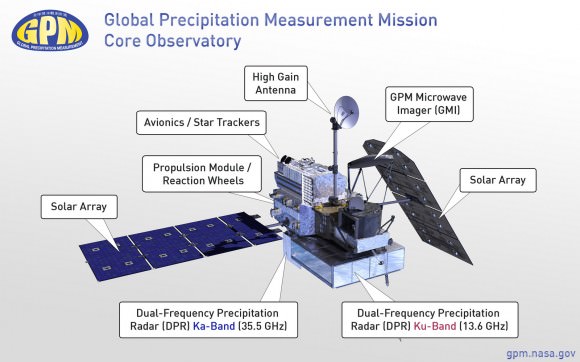
“It is incredibly exciting to see this spacecraft launch,” said Azarbarzin, in a NASA statement. He witnessed the launch in Japan.
“This is the moment that the GPM Team has been working toward since 2006.”
“The GPM Core Observatory is the product of a dedicated team at Goddard, JAXA and others worldwide.”
“Soon, as GPM begins to collect precipitation observations, we’ll see these instruments at work providing real-time information for the scientists about the intensification of storms, rainfall in remote areas and so much more.”
The $933 Million observatory is a joint venture between the US and Japanese space agencies, NASA and the Japan Aerospace Exploration Agency (JAXA).
The 3850 kilogram GPM satellite is equipped with two instruments – an advanced, higher resolution dual -frequency precipitation (DPR) radar instrument (Ku and Ka band) built by JAXA in Japan and the GPM microwave imager (GMI) built by Ball Aerospace in the US.
The GPM observatory will replace the aging NASA/JAXA Tropical Rainfall Measuring Mission (TRMM) satellite launched back in 1997 and also jointly developed by NASA and JAXA.
“GPM is the direct follow-up to the currently orbiting TRMM satellite,” Azarbarzin explained to me.
“TRMM is reaching the end of its usable lifetime. After GPM launches we hope it has some overlap with observations from TRMM.”
GPM is vital to continuing the TRMM measurements. It will help provide improved forecasts and advance warning of extreme super storms like Hurricane Sandy and Super Typhoon Haiyan.
“TRMM was only designed to last three years but is still operating today. We hope GPM has a similar long life,” said Azarbarzin.
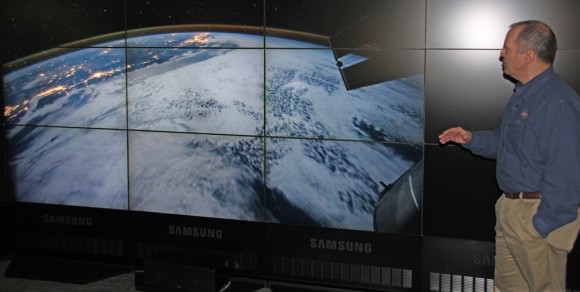
Stay tuned here for Ken’s continuing GPM reports and on-site coverage at NASA Goddard Space Flight Center in Maryland.
And watch for Ken’s continuing planetary and human spaceflight news about Curiosity, Opportunity, Chang’e-3, SpaceX, Orbital Sciences, LADEE, MAVEN, MOM, Mars, Orion and more.
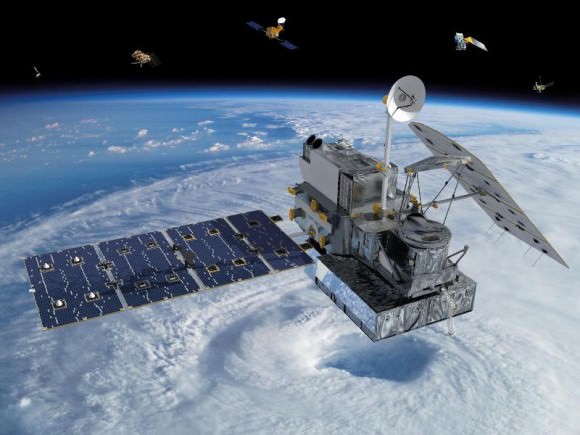
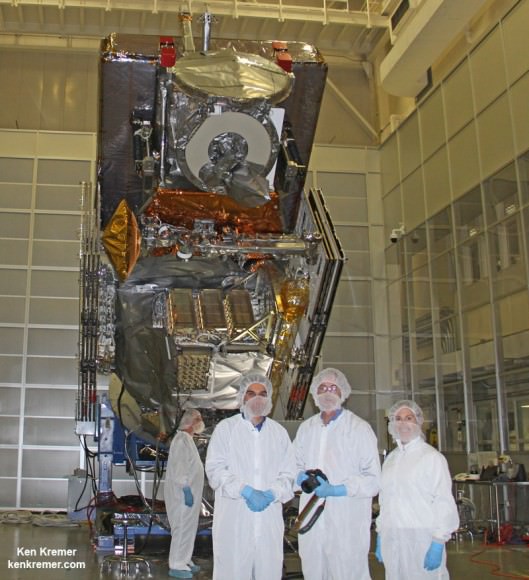
NASA/JAXA Precipitation Measurement Satellite ‘GO’ for Feb. 27 Launch – Watch Live Here on NASA TV
Visualization of the GPM Core Observatory and Partner Satellites. GPM is slated to launch on Feb. 27 from Japan. Credit: NASA
See launch animation, Shinto ceremony, Rocket roll out and more below[/caption]
NASA GODDARD SPACE FLIGHT CENTER, MARYLAND – Blastoff of the powerful and revolutionary new NASA/JAXA rain and snow precipitation measurement satellite atop a Japanese rocket from a tiny offshore island launch pad is now less than 24 hours away on Thursday, Feb. 27, EST (Feb. 28 JST).
The Global Precipitation Measurement (GPM) Core Observatory aimed at improving forecasts of extreme weather and climate change research has been given a green light for launch atop a Mitsubishi Heavy Industries H-IIA rocket from the Tanegashima Space Center on Tanegashima Island off southern Japan.
Roll out of the H-IIA launch vehicle from the Vehicle Assembly Building is scheduled for this evening, Feb. 26 at 11 p.m. EST.
Update: rocket rolled out. Photo below, plus watch streaming NASA TV below.
Following the Launch Readiness Review, mission managers approved the GO for liftoff.
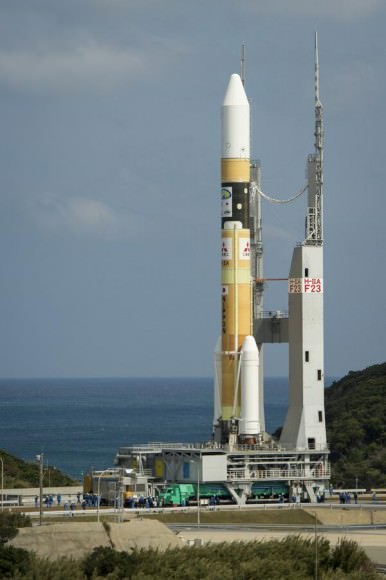
Japanese team members also prayed at a Shinto ceremony for blessings for a successful launch at the Ebisu Shrine, the first shrine in a traditional San-ja Mairi, or Three Shrine Pilgrimage on Tuesday, Feb. 25, 2014 – see photo below.
However, the team also set a newly revised launch time of 1:37 p.m. EST (18:37 UTC, and Feb. 28 at 3:37 a.m. JST).
Live streaming video by Ustream
Mission managers adjusted the H-IIA launch time after concerns raised by a collision avoidance analysis between the GPM spacecraft and the International Space Station (ISS).
GPM will fly at an altitude of 253 miles (407 kilometers) above Earth – quite similar to the ISS.
It’s coverage runs over virtually the entire populated globe from 65 N to 65 S latitudes.
NASA plans live coverage of the launch on Feb. 27 beginning at 12 noon EST on NASA Television.
It will be streamed live at: http://www.nasa.gov/nasatv
The $933 Million observatory is a joint venture between the US and Japanese space agencies, NASA and the Japan Aerospace Exploration Agency (JAXA).

GPM has a one-hour launch window. In case of any delays, the team will be required to conduct a thorough new collision avoidance analysis to ensure safety.
Weather forecast is excellent at this time.
Watch this GPM Launch animation:
Video caption: NASA/JAXA GPM Core Observatory Launch Animation
GPM is a next-generation satellite that will provide global, near real time observations of rain and snow from space. Such data is long awaited by climate scientists and weather forecasters.
It will open a new revolutionary era in global weather observing and climate science. Therefore it will have a direct impact on society and people’s daily lives worldwide.
The mission will significantly advance our understanding of Earth’s water and energy cycles and improve forecasting of extreme weather events.
The 3850 kilogram GPM satellite is equipped with two instruments – an advanced, higher resolution dual -frequency precipitation (DPR) radar instrument (Ku and Ka band) built by JAXA in Japan and the GPM microwave imager (GMI) built by Ball Aerospace in the US.

“The GPM satellite was built in house at NASA’s Goddard Space Flight Center in Maryland,” Art Azarbarzin, GPM project manager, told Universe Today during my exclusive up-close clean room inspection tour of the huge satellite as final processing was underway.
Researchers will use the GPM measurements to study climate change, freshwater resources, floods and droughts, and hurricane formation and tracking.
“GPM will join a worldwide constellation of current and planned satellites,” Azarbarzin told me during an interview in the Goddard cleanroom beside GPM.
“GPM is the direct follow-up to the currently orbiting TRMM satellite,” Azarbarzin explained.
“TRMM is reaching the end of its usable lifetime. After GPM launches we hope it has some overlap with observations from TRMM.”
“The Global Precipitation Measurement (GPM) observatory will provide high resolution global measurements of rain and snow every 3 hours,” Dalia Kirschbaum, GPM research scientist, told me during an interview at Goddard.
Stay tuned here for Ken’s continuing GPM reports and on-site coverage at NASA Goddard Space Flight Center in Maryland.
And watch for Ken’s continuing planetary and human spaceflight news about Curiosity, Opportunity, Chang’e-3, SpaceX, Orbital Sciences, LADEE, MAVEN, MOM, Mars, Orion and more.



